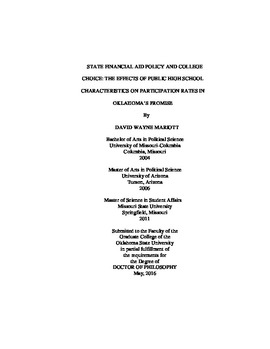| dc.contributor.advisor | Wanger, Stephen P. | |
| dc.contributor.author | Mariott, David Wayne | |
| dc.date.accessioned | 2017-02-22T22:10:07Z | |
| dc.date.available | 2017-02-22T22:10:07Z | |
| dc.date.issued | 2016-05 | |
| dc.identifier.uri | https://hdl.handle.net/11244/48843 | |
| dc.description.abstract | Contemporary models of college choice incorporate contextual factors beyond the individual that shapes college-going attitudes and opportunities for students. One important context at the policy level is the rise of state merit aid programs that constitutes a significant shift in public policy related to college choice. Despite the popularity of these programs, disparities with respect to college access and opportunity continue to exist along racial and socioeconomic lines at the national level and in states such as Oklahoma. The purpose of this study was to determine whether high school factors affected participation rates in Oklahoma's Promise, a state hybrid-aid program that incorporates both merit and need-based eligibility criteria. The research design utilized school-level data from public high schools in the state of Oklahoma from 2004 to 2013. Participation rates were measured as percentages by high school and examined program participation, program completion, and postsecondary choice outcomes. High school factors included the racial, socioeconomic, and academic attributes of the student population for each school and other control variables related to parental engagement, high school staff resources, and college-going rates. Fractional response models evaluated the data with a fixed effects panel approach and also models for individual years. The demographic characteristics of the student population produced mixed results while college-related factors such as the average ACT score and college-going rates were positively associated with higher participation rates. High school resources, measured as the ratio of high school staff to students, were negatively associated with participation rates. The findings suggest that attributes at the high school level can mediate participation rates in Oklahoma's Promise and that policymakers and practitioners should consider how factors at public high schools can affect college choice and related public policy programs. | |
| dc.format | application/pdf | |
| dc.language | en_US | |
| dc.rights | Copyright is held by the author who has granted the Oklahoma State University Library the non-exclusive right to share this material in its institutional repository. Contact Digital Library Services at lib-dls@okstate.edu or 405-744-9161 for the permission policy on the use, reproduction or distribution of this material. | |
| dc.title | State financial aid policy and college choice: The effects of public high school characteristics on participation rates in Oklahoma's Promise | |
| dc.contributor.committeeMember | Fry, Pamela Martin | |
| dc.contributor.committeeMember | Mendez, Jesse Perez | |
| dc.contributor.committeeMember | Mwavita, Mwarumba | |
| osu.filename | Mariott_okstate_0664D_14603.pdf | |
| osu.accesstype | Open Access | |
| dc.type.genre | Dissertation | |
| dc.type.material | Text | |
| thesis.degree.discipline | Educational Leadership and Policy Studies | |
| thesis.degree.grantor | Oklahoma State University | |
